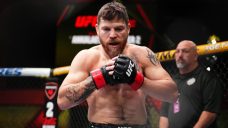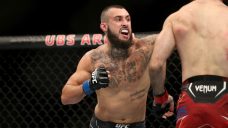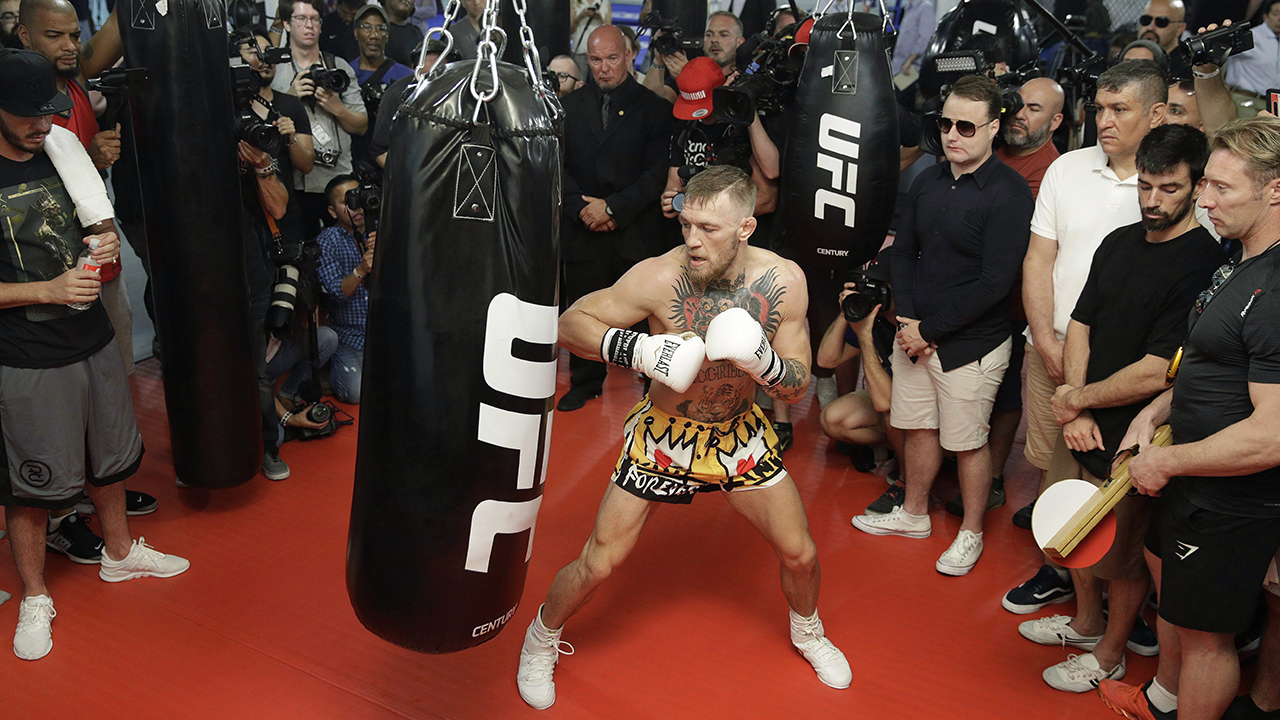Leaving a trail of foul-mouthed, nothing-is-offside, stream-of-everyday-guy-consciousness podcast appearances behind him, Sean Strickland has been consuming a great deal of the MMA world’s attention leading into UFC 297. And his opponent, Dricus Du Plessis, hasn’t been shy to engage with him in an anything-goes war of words — not to mention a war of fists in the stands at UFC 296.
But believe it or not, 22 other fighters are competing Saturday at Scotiabank Arena — many of them exciting, up-and-coming talents in high-stakes fights. Let’s get familiarized with some of the under-the-radar names on the card who may not be making headlines, but could be turning heads come Saturday.
Mayra Bueno Silva (10-2-1)
Granted, it’s odd to identify someone in a literal co-main event title fight as under-the-radar. But given Amanda Nunes’ utter dominance of the bantamweight division over the last eight years — save for a brief spell when Julianna Pena held the belt — fans haven’t had to spend much time considering top women’s challengers at 135.
Meanwhile, Bueno Silva’s been out of sight, out of mind. She’s never been featured on a UFC pay-per-view and her last seven fights were at UFC Apex events. UFC 297 will be her first time competing before a proper audience since prior to the pandemic.
But with Nunes retired, and a vast void left atop the bantamweight picture, Bueno Silva is as well positioned as anyone to fill it. She’ll be at a considerable experience disadvantage in Saturday’s title fight against battle-tested veteran Raquel Pennington. But what separates Bueno Silva isn’t what she brings into her fights — it’s how often she finishes them.
Four of the 32-year-old Brazilian’s six UFC victories have come via first-round submission; one of the other two was a submission late in the second. She’s finished fights with arm bars, a kneebar, and a pair of ninja chokes, including the one she sunk on Holly Holm last July in a second-round victory that was ultimately overturned after Bueno Silva tested positive for Ritalinic acid, a finding she attributed to prescribed ADHD medication.
An 85 per cent finishing rate like hers doesn’t come along often in this division — any division, really. It’s partly thanks to Bueno Silva’s impressive array of submission threats from various positions, partly thanks to an aggressive style that sees her taking the fight to her opponents, cage-cutting and forcing them into the fence.
Against Holm, notorious for using her strength to slow fights down in the clinch, Bueno Silva wasn’t scared to enter the former champion’s preferred environment and work for her opportunity to end things early. Look for Bueno Silva to put a pace on Pennington the same way on Saturday in search of her latest finish. She might just come away with a belt and the recognition she deserves.
Arnold Allen (19-2)
Last April, Allen was riding as much momentum as anyone in the sport, stringing together a 10-fight win streak to begin his UFC career and vaulting himself to top featherweight contender status. But then he ran into living legend Max Holloway, who handed Allen his first defeat in nearly a decade after five competitive rounds.
There’s no shame in losing to a future hall-of-famer, particularly after an entertaining fight in which Allen had his moments, landing several heavy lefts at the end of smooth combinations. But the 29-year-old’s volume waned in the fourth round while Holloway’s increased.
That proved a valuable lesson in Allen’s first exposure to championship rounds. And he seemed to learn from it quickly, as he found an extra gear in the fifth and pressed the action all the way to the horn after his corner told him he needed to find a finish.
Now, after a nine-month layoff, we’ll find out how Allen has grown from that fight as he tries to regain the momentum Holloway halted. Don’t forget the diverse game Allen demonstrated in prior wins over tough competition — Sodiq Yusuff, Dan Hooker, Calvin Kattar. And don’t sleep on how difficult it is to look as good as Allen did against Holloway. You can ask Kattar or Brian Ortega about that.
Allen remains a well-rounded talent who can meet any opponent in any facet of the fight. That ought to be a benefit Saturday as he encounters his latest stiff test atop the division in suffocating wrestler Movsar Evloev.
Movsar Evloev (17-0)
Right, about Evloev. There’s nothing given in a fight against the 29-year-old Russian. He’s undefeated since turning professional in 2014 — a 17-fight stretch that includes unanimous decisions in six of his first seven UFC bouts. He’s a problem. And he keeps getting better.
Over his last three fights, all of which went 15 minutes, Evloev’s averaged more than 7 takedowns, over 8 minutes of control time, and 66 significant strikes per bout. He’s demonstrated a deep gas tank; he’s displayed an array of counters and escapes when threatened with submission attempts; he’s shown timing, fight IQ, and creativity. Again, he’s a problem.
As with most grappling specialists, Evloev still has questions to answer in the stand-up. And a game Diego Lopez — fighting on five days notice — asked a few of them in a surprisingly competitive contest Evloev’s last time out. But even while eating the odd strike in prior fights, Evloev’s looked calm and comfortable in exchanges, utilizing his quickness and athleticism to evade more punishing shots and find entry opportunities as his opponents try to mount attacks.
Now, will Evloev be able to time and withstand those same volleys as he fights more skilled competition? Is his lack of a UFC finish a concern or merely a result of his smothering style? This is what makes Saturday’s confrontation with Allen so intriguing. We stand to learn a lot about two of the UFC’s best up-and-coming featherweights. And if one or the other makes a statement, they’ll inject themselves directly into the title picture at 145.
Brad Katona (13-2)
Here’s how Katona went from UFC prospect on the rise, to fighting dudes you’ve never heard of on a regional circuit in the middle east, to making history in an unlikely UFC return — all in a five-year span.
It began when he won the 27th season of The Ultimate Fighter in 2017, earning victories over Bryce Mitchell (UFC’s No. 10 ranked featherweight) and Kyler Phillips (fighting to enter the stacked bantamweight rankings in a bout with No. 11 Pedro Munhoz at UFC 299) along the way.
After winning that featherweight tournament, Katona moved back down to his natural bantamweight and ran into Georgian buzzsaw Merab Dvalishvili, presently UFC’s No. 2 ranked 135’er and a popular pick as champion-in-waiting. Dvalishvili’s decision over Katona was the second victory on what has since become a dominant, 9-fight win streak.
His next time out, Katona dropped a tight decision to Hunter Azure. The back-and-forth fight could have been scored either way — Katona was out-struck, but he scored three takedowns and earned over six minutes of control time. Regardless, the judges favoured Azure, and Katona was surprisingly released from UFC in early 2020.
Two years later, Katona resurfaced in Brave Combat Federation and went on a four-fight run, winning and defending the Bahrain-based promotion’s bantamweight title before returning to the UFC as a last-minute addition to the 31st season of the Ultimate Fighter. Katona won that competition, too, becoming the show’s first two-time champ.
Interviewed in the octagon following a three-round barn-burner with Cody Gibson at UFC 292, Katona smiled ear-to-ear, blood-streaked on his chest, and yelled into the microphone: “It feels good to be home, baby!”
It's been a remarkable, hard-fought journey for the 32-year-old Winnipeger, who moved to Dublin amidst it to train under SBG Ireland’s John Kavanagh — Conor McGregor’s head coach. And it won’t get any easier Saturday when he encounters Garrett Armfield. Six of Armfield’s 9 professional wins have come via knockout, including a vicious, first-round stoppage of Toshiomi Kazama his last time out.
But Katona proved his mettle as an active, high-output striker against Gibson, racking up 160 significant strikes over three rounds against an opponent who held significant advantages in height (4’) and reach (6.5’). And he’s more than proven his resilience merely to get to this point and earn a second chance in the world’s top promotion. After beating Gibson, Katona said UFC was “where I should have been all along.” Saturday, he has another opportunity to continue proving it.
Sean Woodson (10-1-1)
Standing 6’2 with a compact torso, endless legs, and arms that seem to stretch beyond his knees, Woodson is an awkward fight for any opponent. The featherweight’s 78-inch reach is longer than either of the middleweights fighting in Saturday’s main event. Good luck closing distance against that.
And then there’s the fluid, dynamic offence the 31-year-old’s sending back at you. Leveraging his length to throw from impossible range, Woodson distributes his shots up and down the body, varying angles and timing to force opponents to constantly anticipate and guard an array of attacks, which disrupts their ability to generate their own offence.
His last time out, against Dennis Buzukja, Woodson mixed 36 significant strikes to the head with 18 to the body and 17 to the legs on his way to a unanimous decision. Two fights prior, when he stopped Collin Anglin, he landed 23 to the head, 17 to the body, and 10 to the legs in less than a round.
Hidden behind near-constant feints and unorthodox movement, Woodson’s flowing striking game puts constant pressure on featherweights who will have seldom encountered such a tall, long competitor. It’s a fun style to watch from outside the octagon. But an absolute handful to deal with for Woodson’s opponent inside it.







COMMENTS
When submitting content, please abide by our submission guidelines, and avoid posting profanity, personal attacks or harassment. Should you violate our submissions guidelines, we reserve the right to remove your comments and block your account. Sportsnet reserves the right to close a story’s comment section at any time.